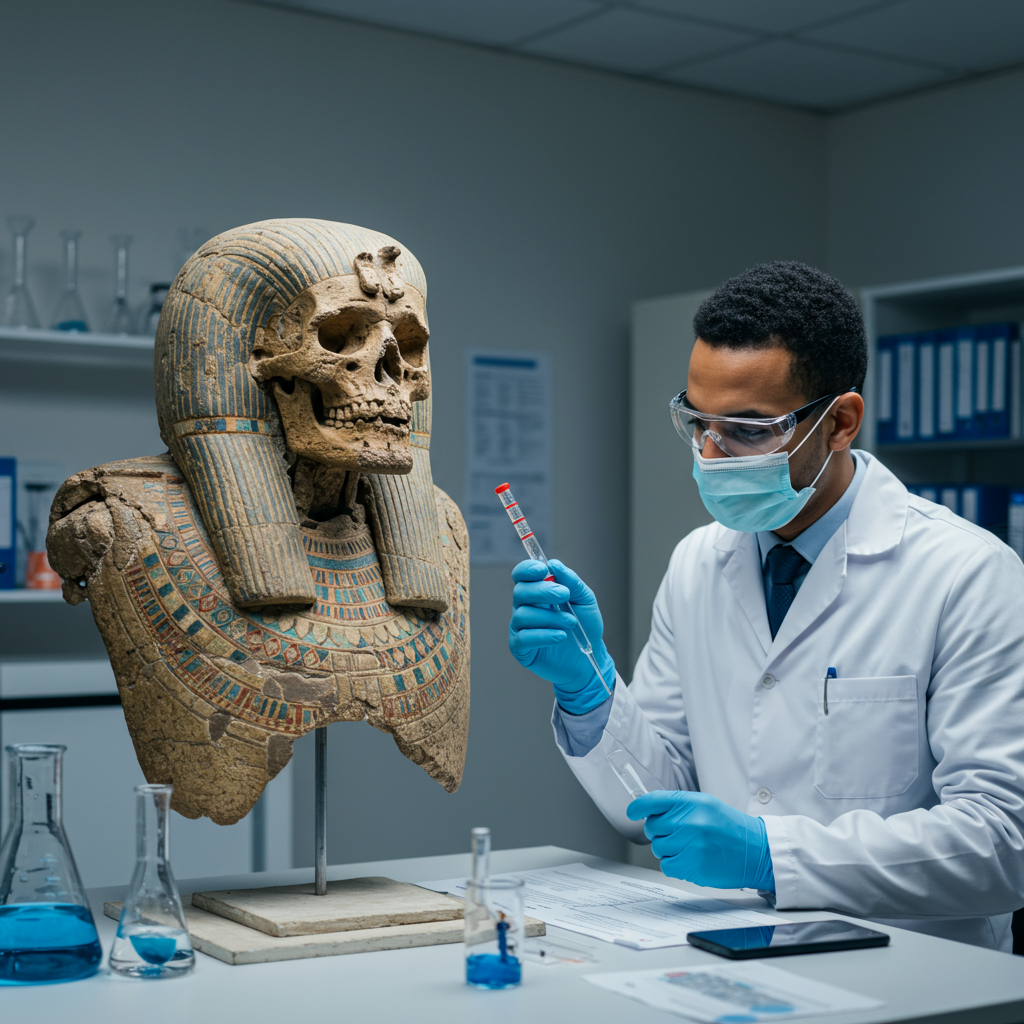History books often tell grand narratives of pharaohs and empires, largely drawn from monumental inscriptions and elite records. But what if the true story of civilization’s rise lies hidden within the bones of ordinary people? A groundbreaking DNA test on a man who lived over 4,500 years ago in egypt‘s fertile Nile Valley is forcing experts to rethink how ancient civilizations grew. This single discovery provides the first direct biological evidence of deep connections between ancient Egypt and another powerful center of the time: Mesopotamia. It’s a finding that could dramatically reshape our understanding of how writing, agriculture, and statehood emerged in these foundational cultures.
Unearthing an Ancient Secret
The subject of this potentially history-altering study was a man buried in a village called Nuwayrat, located approximately 265km south of modern-day Cairo. His remains date back 4,500 to 4,800 years ago. This era was a pivotal moment when both Egyptian and Mesopotamian societies were undergoing rapid transformation. He was not mummified using later, more common methods; instead, he was interred in a ceramic pot within a tomb carved into a hillside. This less elaborate burial may have inadvertently helped preserve his genetic material for millennia.
Remarkably, the skeleton itself has a history of survival. Excavated in 1902, it was donated to the World Museum Liverpool. There, it narrowly survived the devastating bombings of the Blitz during World War II, which destroyed much of the museum’s other human remains collection. Dr. Linus Girdland Flink highlighted this as a “tremendous stroke of luck,” allowing the skeleton to be available for study today.
Scientists extracted and analyzed DNA from a bone in the inner ear, a site known for good DNA preservation. The results were astonishing. The analysis revealed that roughly one-fifth (20%) of the man’s DNA came from ancestors living some 1,500 kilometers away in Mesopotamia, a region corresponding to modern-day Iraq. This genetic link, originating from the area broadly known as the Fertile Crescent, provides tangible proof of interaction across vast distances in the ancient world.
Bridging the Civilizations: People, Not Just Ideas?
For decades, archaeologists and historians have debated the extent of contact and influence between early Egypt and Mesopotamia. Both regions independently developed some of the world’s first complex societies, including foundational advancements like writing systems, organized agriculture, and large-scale administration. Many scholars suspected that the development of writing and the adoption of agriculture in Egypt were influenced by earlier innovations in Mesopotamia. Archaeological findings, such as pottery styles or architectural similarities, have hinted at connections potentially dating back as far as 10,000 years ago, aligning with the emergence of farming in Mesopotamia.
However, direct evidence of human movement between these distant lands has been scarce. Adeline Morez Jacobs, who analyzed the remains as part of her PhD research, stated this is the first clear-cut biological evidence of significant migration. This finding strongly supports the theory that the exchange wasn’t merely of abstract ideas or goods, but involved actual people traveling and settling, bringing their knowledge and practices with them.
Professor Pontus Skoglund, the lead researcher from the Francis Crick Institute, explained that the ability to extract and read ancient DNA offers a powerful new lens on the past. It allows scientists to move beyond interpreting artifacts and written records to understand the biological origins and movements of the people themselves. This provides a “technicolour” view compared to the “black and white” facts often gleaned from traditional sources, according to Skoglund.
A Life Revealed: The Story of One Ancient Man
Beyond his surprising ancestry, the skeleton provided intimate details about the man’s life. Prof. Joel Irish at Liverpool John Moores University conducted a meticulous analysis of the bones. His goal was to understand the individual, not just treat the remains as a scientific specimen. By studying wear patterns, bone structure, and chemical signatures, researchers pieced together a biography of this ancient Egyptian inhabitant.
Chemical analysis of his teeth suggested that he grew up in Egypt, indicating that his Mesopotamian ancestry was likely from previous generations who had migrated to the Nile Valley. The skeletal analysis offered even more clues about his daily life and profession. He was estimated to be between 45 and 65 years old, leaning towards the older end due to evidence of arthritis. Standing just over 5ft 2in tall, he was considered short even by the standards of his time.
Specific physical traits painted a vivid picture of his labor. An enlarged hook-shaped bone at the back of his skull suggested he spent significant time looking downwards, potentially focusing on detailed work. Expanded seat bones indicated he frequently sat on hard surfaces for long periods. His arm bones showed evidence of substantial muscle growth and extensive back-and-forth movement. Markings on his arms pointed to a history of lifting heavy objects.
Combining these observations, researchers concluded that he most likely worked as a potter throughout his life. The physical demands of this craft, involving looking down at clay, sitting at a wheel or workspace, and lifting heavy pots, align perfectly with the skeletal evidence. As Prof. Irish remarked, the man’s bones showed he “worked his tail off” his entire life. This level of detail offers a rare glimpse into the existence of an ordinary working person from this distant past, a perspective often missing from historical accounts focused on elites.
The Power of Ancient DNA Analysis
This study exemplifies the transformative potential of ancient DNA technology in historical research. By complementing traditional archaeological findings and the limited written records from this period (which often focus on the rich and powerful), genetic analysis provides a unique and unbiased source of information about human populations, migrations, and interactions.
The findings, published in the prestigious journal Nature, demonstrate that ancient DNA can reveal previously unknown connections between seemingly disparate cultures. As Adeline Morez Jacobs noted, while archaeologists theorized about contact between Egypt and Mesopotamia based on cultural similarities, now there is tangible biological proof.
Researchers hope that future DNA studies on more ancient Egyptian remains will further illuminate the timeline and scale of migrations from West Asia, providing a more complete picture of the genetic landscape of the Nile Valley during this crucial formative period. Integrating DNA data with existing archaeological, cultural, and written information promises to unlock even more secrets about ancient societies and the movements of people that shaped them.
Implications for Understanding Early Civilizations
The discovery of Mesopotamian ancestry in a 4,500-year-old Egyptian suggests that the rise of two of the world’s earliest and most influential civilizations was not necessarily an isolated process. Instead, it hints at a degree of interconnectedness and human mobility that facilitated the exchange of ideas, technologies, and perhaps even contributed to the foundational innovations like writing and agriculture in both regions.
This specific finding lends new weight to the argument that early civilization was, to some extent, a collaborative or mutually influenced phenomenon driven by the movement of people across significant distances. It challenges simpler narratives of purely independent development and underscores the dynamic nature of ancient populations. This single ancient individual, through the story told by his bones and DNA, provides a powerful reminder that history is not just about kings and monuments, but also about the lives, movements, and genetic legacy of ordinary people.
Frequently Asked Questions
What did the DNA test on the ancient Egyptian man reveal about his ancestry?
The DNA test on the man who lived 4,500 years ago in Egypt’s Nile Valley revealed that approximately 20% of his genetic ancestry originated from Mesopotamia, a region about 1,500 kilometers away in modern-day Iraq. This is the first biological evidence of significant human migration or contact between these two major ancient civilizations during their formative period.
Where were the remains of this ancient Egyptian man found and studied?
The man’s remains were found buried in a ceramic pot in a tomb in Nuwayrat, a village located about 265 kilometers south of Cairo, Egypt. The skeleton was excavated in 1902 and later donated to the World Museum Liverpool in the UK. It survived the WWII Blitz bombings there and was subsequently studied by researchers at institutions including the Francis Crick Institute and Liverpool John Moores University.
Why is finding Mesopotamian DNA in ancient Egypt considered a significant discovery?
Finding Mesopotamian DNA in ancient Egypt is significant because it provides direct biological proof of human movement and interaction between these two powerful and distant civilizations around 4,500 years ago. While archaeologists suspected contact based on shared developments like writing and agriculture, this DNA evidence confirms that people physically traveled between the regions, potentially facilitating the exchange of ideas and technologies that shaped the emergence of both societies.
Conclusion
The analysis of a single ancient Egyptian man’s DNA and skeleton has opened a fascinating window into the deep past. It offers compelling biological evidence of significant human connections between ancient Egypt and Mesopotamia during a crucial period of civilization building. By revealing both distant ancestry and the intimate details of a likely potter’s life, this research demonstrates how modern scientific techniques can bring history to life, offering new perspectives on the interconnectedness of the ancient world and the experiences of ordinary people who shaped it. As more ancient DNA is analyzed, our understanding of these foundational eras may be further enriched, potentially leading to significant revisions of historical narratives.




